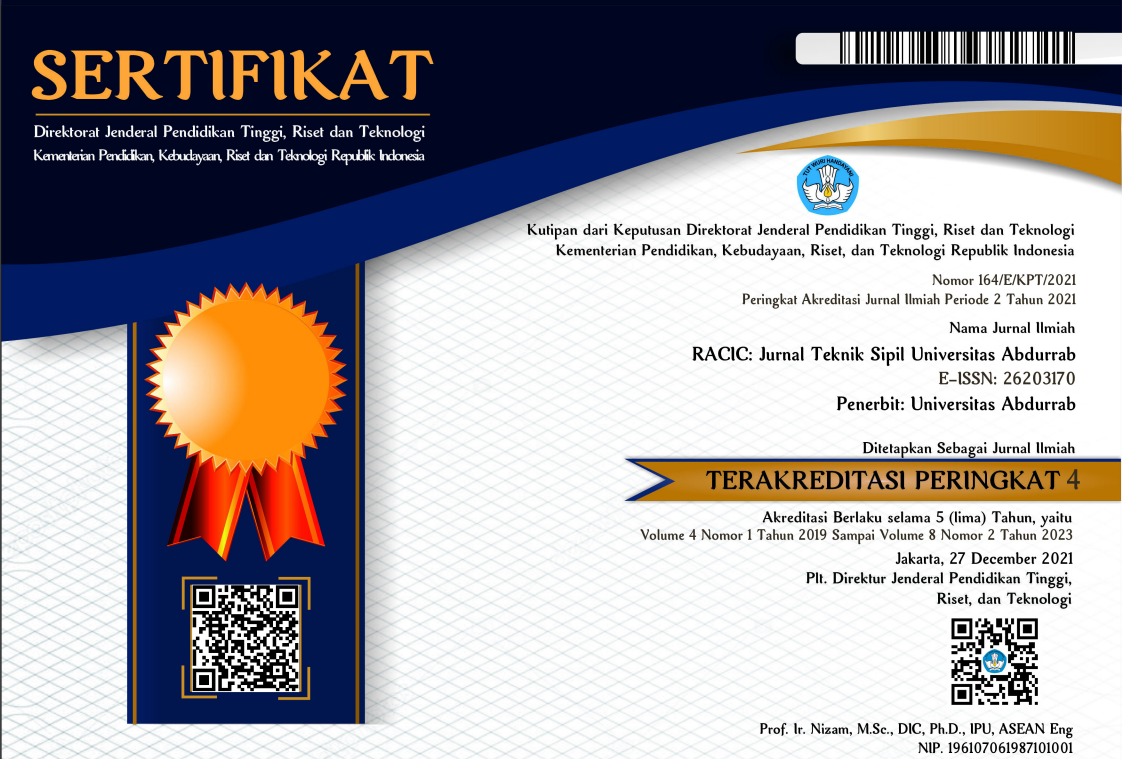PENGARUH VARIASI PENAMBAHAN SEMEN DAN PERBEDAAN SUHU SAAT PENCAMPURAN TERHADAP MUTU BETON
DOI:
https://doi.org/10.36341/racic.v8i2.4014Keywords:
Effect of Cement Addition on Concrete QualityAbstract
Concrete is one of the building structural elements consisting of a mixture of aggregate as a filler and cement paste as a binder. Improving the quality of the concrete mixture will produce concrete with high or maximum compressive strength. Many people think and assume that the more cement used in a concrete mix, the quality/strength will increase. Actually, this assumption is not completely wrong and not completely correct and here the author will try to examine whether adding a lot of cement will improve the quality of the concrete and see the effect of temperature on the quality of the concrete mixture. Variations in adding cement from 450 kg, 500 kg, and 550 kg showed an increase in concrete quality, with compressive strength values of 34.19 MPa, 37.40MPa, and 42.01MPa, while variations in adding 600kg cement experienced a decrease in concrete quality. With a compressive strength value of 41.16MPa. From this research, adding cement does not always improve the quality of concrete. Variations in adding cement of 450kg, 500kg, 550kg and 600kg during morning mixing with a mixing temperature of 24°C with compressive strength values of 33.22 MPa, 37.3MPa, 40.51MPa and 44.69MPa, show increasing quality values. Meanwhile, during the afternoon mixing time with a mixing temperature of 32℃, variations in the addition of 450kg, 500kg and 550kg cement showed that the compressive strength results continued to increase, namely with compressive strength values of 34.19MPa, 37.40MPa and 42.01MPa. Meanwhile, by adding 600 kg of cement variation, the compressive strength value was found to be 41.16MPa, where the concrete experienced a decrease in the compressive strength value. So it can be concluded that mixing the concrete mixture in the morning with a mix temperature of 24℃ is better than in the afternoon with a mix temperature of 32℃
Downloads
References
Amelia,R. & Rosyad,F. (2018). Analisis Perbandingan Jenis Semen (Merk Semen) Terhadap Kuat Tekan Beton.
Ariski intan sari,R.,Steenie,E., & Windah.(2015) Pengaruh jumlah semen dan fas terhadap kuat tekan beton dengan agregat yang berasal dari sungai.
Fauzi,M., Puspita,N. & Al Iswana,M. (2022). Pengaruh Suhu Dan (Curing) Air Laut Terhadap Beton fc’30 Mpa Dengan Agregat Kasar Batu Pandai.
Mulyono ,T .2004. Teknologi Beton. Edisi Kedua. Yogyakarta : Penerbit Andi.
Tjokrodimuljo, K. 2007. Teknologi Beton. Yogyakarta : Biro Penerbit Teknik Sipil Universitas Gaja Mada.
Nasional, Badan Standarisasi. (2000). SNI 03-2834-2000 Tata Cara Pembuatan Rencana Campuran Beton Normal. BSN, Jakarta.
Paembonan,M.,Kadir,A.,Lewiskinta,A & sulha (2022). Analisis Perbandingan Kualitas Semen X Dengan Semen Y Terhadap Kuat Tekan Beton Fc’ 20 MPA Dan FC’ 30 MPA.
Rahmani,H. & Gazali,A.(2019). Pengaruh Suhu Bahan Campuran Terhadap Sifat dan Mutu Beton Dalam Pelaksaan Drainase Jalan Pada Daerah Terpencil di Provinsi Kalimantan.
Rinaldi basri,D. & Mubarak,H .(2022). Beton Ringan dengan Bahan Plastik sebagai Agregat Kasar untuk Konstruksi di Atas Lahan Gambut.
SNI 03-1968-1990. Metode pengujian tentang analisi saringan agregat halus dan kasar.Bandung:Badan Standar Nasional
Sofyan.,fasdarsyah.,sarana,D& setiawan,M. (2022). Studi Ekspremental Pengaruh Variasi Suhu Campuran Beton Dengan Tambahan Sikament NN Terhadap Campaian Mutu Beton.
Teruna,D. & Tanoto,F. (2018). Pengaruh Variasi Termperatur Pada Mikrobakteri Blocong Sebagai Subtitusi Semen Terhadap Kuat Tekan Beton . Skipsi.Program Studi Teknik sipil. Universitas Sumatera Utara.
Universitas Abdurrab.2017. Pedoman Penulisan Tugas Akhir dan Kerja Praktek.
Pekanbaru:Universitas Abdurrab
Universitas Abdurrab.2019. laporan pratikum bahan bangunan.
Pekanbaru:Kelompok Dua (2) Universitas AbdurrabWeking.F (2019). Pengaruh Variasi Semen Terhadap Kuat Tekan Beton Dengan Zat Tambahan Beton Mix’’.
Wijoyo,S.,Zulhendri, Alfajrizal,M., & Puri,A.(2018). Kajian Perbadingan Penggunaan Berbagai Merek Semen Dengan Dan Tampa Perawatan Terhadap Kuat Lentur Beton Pada Perkesan Kaku.
Downloads
Published
Issue
Section
License
1. Copyright of all journal manuscripts is held by the RACIC : Rab Construction Research
2. Formal legal provisions to access digital articles of electronic journal are subject to the provision of the Creative Commons Attribution-ShareAlike license (CC BY-NC-SA), which means that RACIC : Rab Construction Research is rightful to keep, transfer media/format, manage in the form of databases, maintain, and publish articles.
3. Published manuscripts both printed and electronic are open access for educational, research, and library purposes. Additionally, the editorial board is not responsible for any violations of copyright law.
licensed under a Creative Commons Attribution-ShareAlike 4.0 International License.





